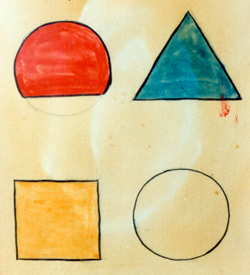Buddhist practice and Buddhist art have been inseparable in the Himalayas ever since Buddhism arrived to the region in the eighth century. But for the casual observer it can be difficult to make sense of the complex iconography. Not to worry—Himalayan art scholar Jeff Watt is here to help. In this “Himalayan Buddhist Art 101” series, Jeff is making sense of this rich artistic tradition by presenting a weekly image from the Himalayan Art Resources archives and explaining its role in the Buddhist tradition. Last week we looked at Mandalas, and we continue the exploration this week with Mandalas Part II.
Himalayan Buddhist Art 101: Mandalas Part II
Last week we discussed the two principal types of mandalas: offering mandalas and deity mandalas. These two types of mandalas are the most common and most important in the life of a Vajrayana Buddhist. Following from this are many more minor forms of mandalas that do not appear in art as often but become important depending on the type of meditation and ritual practice one is engaged in.
 The most elementary form of mandala visualization is based on the four elements of earth, fire, water and air—called the “four element mandalas.” This practice is also found in the Southern Buddhist traditions. The four elements, represented by shapes and colors, are mentally visualized, one at a time, in front of the seated practitioner. The different Tibetan traditions might present them in slightly different ways, some simple in design and others more elaborate. Within each Tantric Buddhist logic system the shapes and colors are generally consistent. The small painting shown here, used in ritual initiations, depicts all four of the basic element mandalas.
The most elementary form of mandala visualization is based on the four elements of earth, fire, water and air—called the “four element mandalas.” This practice is also found in the Southern Buddhist traditions. The four elements, represented by shapes and colors, are mentally visualized, one at a time, in front of the seated practitioner. The different Tibetan traditions might present them in slightly different ways, some simple in design and others more elaborate. Within each Tantric Buddhist logic system the shapes and colors are generally consistent. The small painting shown here, used in ritual initiations, depicts all four of the basic element mandalas.
Another form of mandala that is very important for Vajrayana Buddhist practice, yet considered very esoteric and for initiates only, is the “internal body mandala.” Body mandalas are related specifically to the physical human body of the Tantric practitioner—the nervous system, veins, arteries, spine and principal joints of the body. All of these physical parts of the body are visualized (imagined) to be major and minor deities. Body mandala theory and practice is found in many of the religious and spiritual movements of Asia such as the Hindu Shaiva, Hindu Shakta, Tantric Buddhist, Bon, and Taoist religions.
 In Tantric Buddhism body mandalas are taught in the major Anuttarayoga systems of Indian Tantric literature, such as the Chakrasamvara, Guhyasamaja, and Hevajra Tantras. Each of these Tantras have different explanations for naming the individual deities, and minor differences in describing and explaining the meanings and functions of the internal body mandala. The external visualized mandala commonly portrayed in art and the internal body mandala work together in meditation practice. It is also this body mandala theory that is at the heart of Tantric Buddhist physical yoga, breathing excersises, and practice.
In Tantric Buddhism body mandalas are taught in the major Anuttarayoga systems of Indian Tantric literature, such as the Chakrasamvara, Guhyasamaja, and Hevajra Tantras. Each of these Tantras have different explanations for naming the individual deities, and minor differences in describing and explaining the meanings and functions of the internal body mandala. The external visualized mandala commonly portrayed in art and the internal body mandala work together in meditation practice. It is also this body mandala theory that is at the heart of Tantric Buddhist physical yoga, breathing excersises, and practice.
The body mandala depicted here is a Nepalese painting illustrating the placement of the deities in the body according to the very popular Chakrasamvara Tantra. The colored lines extending from the meditator’s body to the various deities pictured at the right and left are only indicating the location in the body where that specific deity resides. Although with paintings it is not easy to locate all of the figures within the diagram of the body, when visualizing the individual deities they are imagined as being very small but very clear.
—Jeff Watt
Suggested Links
Chakrasamvara Body Mandala (full image)
Four Elements Mandala
Body Mandala Main Page
Mandala Technical Glossary
Thank you for subscribing to Tricycle! As a nonprofit, we depend on readers like you to keep Buddhist teachings and practices widely available.